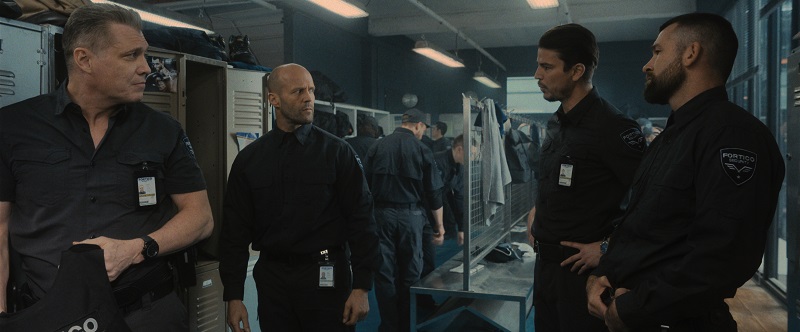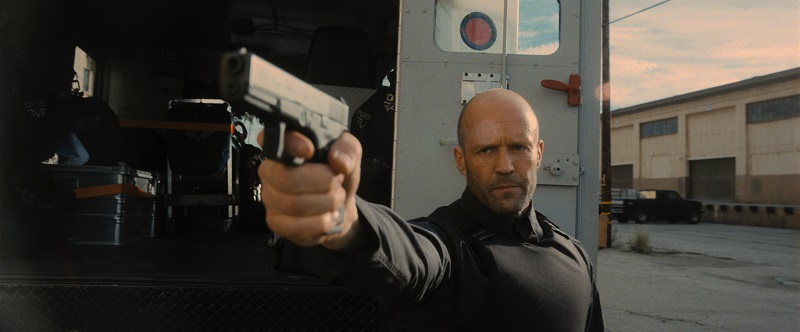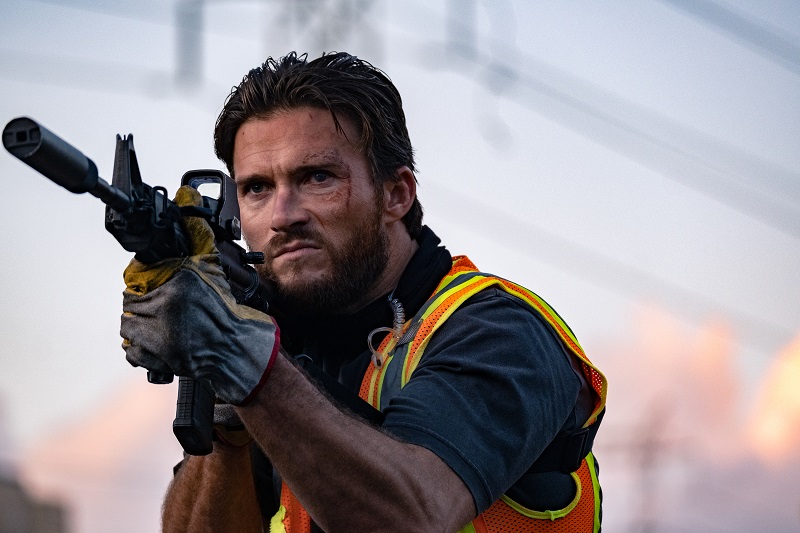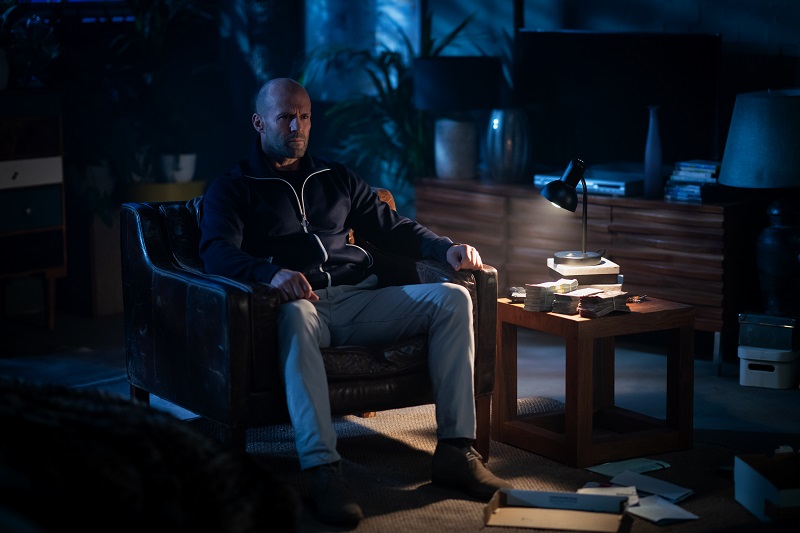Guy Ritchie and Jason Statham famously first worked as director and actor in the 1998 gem that is Lock, Stock and Two Smoking Barrels and then again in the 2000 instant classic Snatch. It’s taken 20 years, but the dynamic duo is back together working in the crime milieu with Wrath of Man. This time out, the filmmaker and his action star have swapped London for The City of Angels, Los Angeles.
Statham, known only as H, is the new guy at an armored truck security company. Everything about him is mysterious. He’s English, clearly from his accent. Why he’s in America or Los Angeles is never addressed, but does it really matter? It’s Jason Statham and he’s an armed guard driving around with millions that he’s charged with protecting.
His references, background check… heck, everything checks out and the man is set for training with Bullet (Holt McCallany). The action hero is a blank slate and given the fact that he barely passed his firearms test, when he rises to the occasion becomes a one-man killing machine during a heist soon after hiring… it’s a little shocking to his fellow employees—but they love it. He’s suddenly quite the popular guy. One thing is clear, though, and that is that Statham is playing someone who when no one is looking, is a guy on a mission.
What that is, Ritchie keeps close to the vest until he does something fascinating with the narrative.
He goes back five months. In a move that should be surprising to nobody, Statham is not a lifelong armed car veteran. What Ritchie has achieved with his time switch is turn a film whose premise was puzzling into a true puzzle. It was impressive how the set-up and then the flashback all come together for a third act whose stakes couldn’t be higher. Wrath of Man, as hinted at by the film’s moniker, is a tale of vengeance. Like a snake in the grass patiently waiting, Statham’s H has plotted this entire endeavor out in the most vendetta-driven divine manner.
Ritchie co-wrote the script with Ivan Atkinson and Marn Davies, which was in turn based on the French film, Le Convoyeur. It is fitting that the filmmaker changed things up a bit by altering locales from his usual landscape of London. From the outside looking in, it appears to have freed the storyteller of his usual tropes as there are none here that would have one think this is a “classic” Guy Ritchie film. He, in turn, is allowed to focus on the moving pieces of the plot and telling what amounts to a short(er) story from a number of perspectives.
The Sherlock Holmes filmmaker makes some bold choices, and for the most part, they pay off. Ritchie is slowly, but surely, putting together a riddle, and as the shoes drop, anticipating where this story goes is a useless undertaking. Just let go and enjoy the ride because just when you think you’ve got it figured out, the rug gets pulled from underneath you.

Wrath of Man possesses the feel of a quintessential LA crime story, think Heat, Collateral, or To Live and Die in LA, although it is not quite in the same league as those classics—but what LA crime movies are?! What’s intriguing is how many times these City of Angels-set films can have the city feel like a character. That is not the case with Ritchie’s film. We are firmly in Statham and Ritchie’s world and everything that that means. Countless establishing shots showing the skyline or the palm tree-lined streets (even a subway train going by with the Lakers iconic logo) all give us that LA story sense. But this is about one man who is on a mission to make people pay.
The cast is game, especially Jeffrey Donovan, Josh Hartnett, Andy Garcia, Raúl Castillo, Scott Eastwood, and Ritchie veteran, Eddie Marsan. To describe some of their characters would be spoiler-territory, but let’s just say that when it is revealed that this major event that occurred that changed everyone’s lives had help from the inside, the actors’ collective performances all have us wondering where allegiances lie. It’s another feather in the cap of Ritchie for his first Los Angeles-set flick.
Statham has never been an actor with long monologues or stretches where anything other than his fists does the talking. Yet, for the first act of Wrath of Man, he says truly little. As such, Ritchie has his leading man doing most of the audience forming an opinion about this character, based solely on how the actor carries himself and responds to others. It’s a different base of operations for these two (actor and director) and it honestly adds a whole lot of impact when we do start to figure out the answers to some of these nagging questions that permeate the first 30 minutes of the film. Once Statham does get into the action, there is something distinctive about it in his third collaboration with Ritchie. The man who punched a shark in the face in The Meg has a purpose that we can see in his eyes and not just feel by his fists or his weapons.

It was nice to see Hartnett get in on a little action. The actor who seemed to be everywhere not too long ago portrays a questionable character here in Boy Sweat Dave (oh, Guy and your character monikers!). First, he clashes with H almost immediately. Then, he always seems to be looking for an easy way out. It’s a subtle thing, but his turn plays a huge role in keeping the mystery festering. Eastwood, on the other hand, audiences will have his character pegged from the get-go. He plays Jan and who this guy is and what he is about is clear immediately and that has everything to do with his performance.
What’s so interesting is that fans have waited for two decades for Statham and Ritchie to reteam and Wrath of Man doesn’t feel like a typical film from either man. That’s a good thing, or a bad thing depending on your perspective. For this longtime fan and full-time film appreciator, it’s a mixed bag. The flick is engrossing from the first frame, so it was easy to not pay any attention to the fact that it didn’t feel like a Ritchie flick. That’s fine though. Filmmakers change things up sometimes (one would hope!) and sometimes the results are solid and other times, not so much. Think when Ron Howard tackled the Formula 1 racing story that is Rush. Doesn’t seem like a Howard-type tale or landscape he would paint with his filmmaking strokes. But in the end, in my opinion, it’s his best movie.

Now, Wrath of Man is not Ritchie’s best movie. That debate is a whole different article. It lies somewhere in the upper-middle region of the movie man’s work. The man knows how to create tension and execute action sequences that are uniquely his. The thing about his latest is that it is just so matter-of-fact. It’s refreshing. One can always go back to showing us the outcome, and then cinematically lead us to how we got there! For this instance, it was nice to know that a scene with a bevy of bandits trying to rip off an armored car is exactly that. Inherently, that raises the heart rate. There’s no reason to put your traditional cinematic stamp on it. That shows self-awareness in a filmmaker. That illustrates growth. In the end, isn’t that what we all should be doing?
Grade: B


